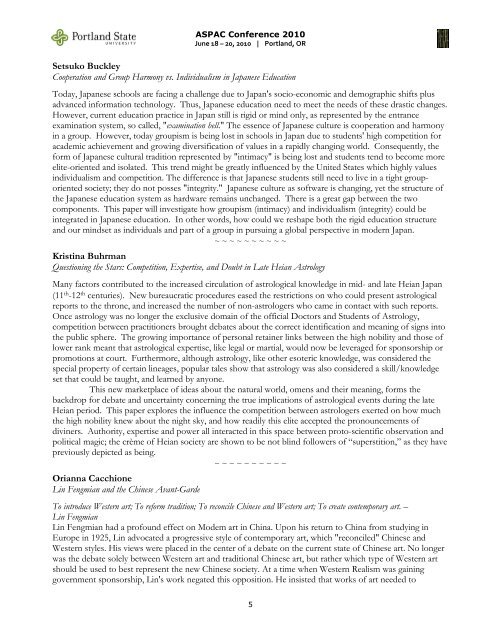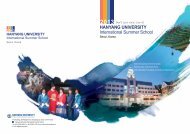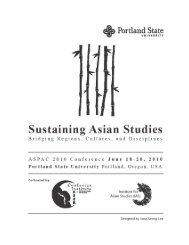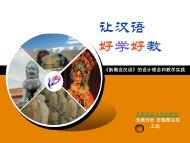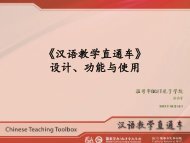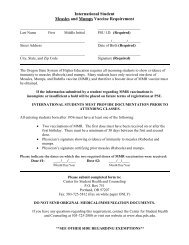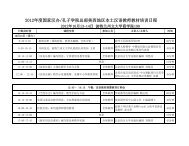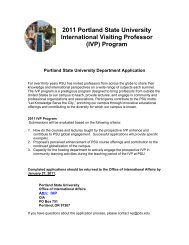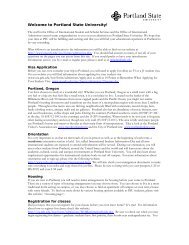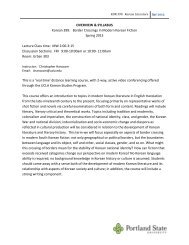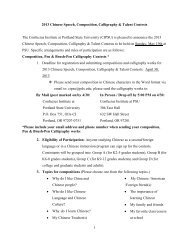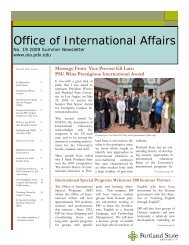ABSTRACTS - oia - Portland State University
ABSTRACTS - oia - Portland State University
ABSTRACTS - oia - Portland State University
You also want an ePaper? Increase the reach of your titles
YUMPU automatically turns print PDFs into web optimized ePapers that Google loves.
ASPAC Conference 2010<br />
June 18 – 20, 2010 | <strong>Portland</strong>, OR<br />
Setsuko Buckley<br />
Cooperation and Group Harmony vs. Individualism in Japanese Education<br />
Today, Japanese schools are facing a challenge due to Japan's socio-economic and demographic shifts plus<br />
advanced information technology. Thus, Japanese education need to meet the needs of these drastic changes.<br />
However, current education practice in Japan still is rigid or mind only, as represented by the entrance<br />
examination system, so called, "examination hell." The essence of Japanese culture is cooperation and harmony<br />
in a group. However, today groupism is being lost in schools in Japan due to students' high competition for<br />
academic achievement and growing diversification of values in a rapidly changing world. Consequently, the<br />
form of Japanese cultural tradition represented by "intimacy" is being lost and students tend to become more<br />
elite-oriented and isolated. This trend might be greatly influenced by the United <strong>State</strong>s which highly values<br />
individualism and competition. The difference is that Japanese students still need to live in a tight grouporiented<br />
society; they do not posses "integrity." Japanese culture as software is changing, yet the structure of<br />
the Japanese education system as hardware remains unchanged. There is a great gap between the two<br />
components. This paper will investigate how groupism (intimacy) and individualism (integrity) could be<br />
integrated in Japanese education. In other words, how could we reshape both the rigid education structure<br />
and our mindset as individuals and part of a group in pursuing a global perspective in modern Japan.<br />
~ ~ ~ ~ ~ ~ ~ ~ ~ ~<br />
Kristina Buhrman<br />
Questioning the Stars: Competition, Expertise, and Doubt in Late Heian Astrology<br />
Many factors contributed to the increased circulation of astrological knowledge in mid- and late Heian Japan<br />
(11 th -12 th centuries). New bureaucratic procedures eased the restrictions on who could present astrological<br />
reports to the throne, and increased the number of non-astrologers who came in contact with such reports.<br />
Once astrology was no longer the exclusive domain of the official Doctors and Students of Astrology,<br />
competition between practitioners brought debates about the correct identification and meaning of signs into<br />
the public sphere. The growing importance of personal retainer links between the high nobility and those of<br />
lower rank meant that astrological expertise, like legal or martial, would now be leveraged for sponsorship or<br />
promotions at court. Furthermore, although astrology, like other esoteric knowledge, was considered the<br />
special property of certain lineages, popular tales show that astrology was also considered a skill/knowledge<br />
set that could be taught, and learned by anyone.<br />
This new marketplace of ideas about the natural world, omens and their meaning, forms the<br />
backdrop for debate and uncertainty concerning the true implications of astrological events during the late<br />
Heian period. This paper explores the influence the competition between astrologers exerted on how much<br />
the high nobility knew about the night sky, and how readily this elite accepted the pronouncements of<br />
diviners. Authority, expertise and power all interacted in this space between proto-scientific observation and<br />
political magic; the crème of Heian society are shown to be not blind followers of “superstition,” as they have<br />
previously depicted as being.<br />
~ ~ ~ ~ ~ ~ ~ ~ ~ ~<br />
Orianna Cacchione<br />
Lin Fengmian and the Chinese Avant-Garde<br />
To introduce Western art; To reform tradition; To reconcile Chinese and Western art; To create contemporary art. –<br />
Lin Fengmian<br />
Lin Fengmian had a profound effect on Modem art in China. Upon his return to China from studying in<br />
Europe in 1925, Lin advocated a progressive style of contemporary art, which "reconciled" Chinese and<br />
Western styles. His views were placed in the center of a debate on the current state of Chinese art. No longer<br />
was the debate solely between Western art and traditional Chinese art, but rather which type of Western art<br />
should be used to best represent the new Chinese society. At a time when Western Realism was gaining<br />
government sponsorship, Lin's work negated this opposition. He insisted that works of art needed to<br />
5


